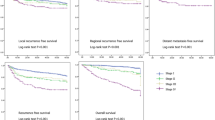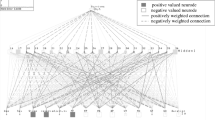Abstract
The accepted method of modelling and predicting failure/survival, Cox’s proportional hazards model, is theoretically inferior to neural network derived models for analysing highly complex systems with large datasets. A blinded comparison of the neural network versus the Cox’s model in predicting survival utilising data from 873 treated patients with laryngeal cancer. These were divided randomly and equally into a training set and a study set and Cox’s and neural network models applied in turn. Data were then divided into seven sets of binary covariates and the analysis repeated. Overall survival was not significantly different on Kaplan–Meier plot, or with either test model. Although the network produced qualitatively similar results to Cox’s model it was significantly more sensitive to differences in survival curves for age and N stage. We propose that neural networks are capable of prediction in systems involving complex interactions between variables and non-linearity.




Similar content being viewed by others
References
Altman DG (1999) Practical statistics for medical research. Chapman and Hall, London, pp 387–395
Hair JF Jr, Anderson RE, Tatham RL, Black WC (1988) Multivariate data analysis, 5th edn. Pearson Education, New Jersey, pp 684–692
Cox DR (1999) Regression models and life tables. J R Stat Soc B 34:187–220
Kates R, Schmitt M, Harbeck N (2003) Advanced statistical methods for the definition of new staging models. Recent Results Cancer Res 162:101–113
Drago GP, Setti E, Licitra L, Liberati D (2002) Forecasting the performance status of head and neck cancer patient treatment by an interval arithmetic pruned perceptro. IEEE Trans Biomed Eng 49:782–787
Grumett S, Snow P, Kerr D (2003) Neural networks in the prediction of survival in patients with colorectal cancer. Clin Colorectal Cancer 2:239–234
Lundin M, Lundin J, Burke HB, Toikkanen S, Pylkkanen L, Joensuu H (1999) Artificial neural networks applied to survival prediction in breast cancer. Oncology 57:281–286
Snow PB, Kerr DJ, Brandt JM, Rodvold DM (2001) Neural network and regression predictions of 5 year survival after colon carcinoma treatment. Cancer 91(8 Suppl):1673–1678
Marchevsky AM, Patel S, Wiley KJ, Stephenson MA, Gondo M, Brov RW et al (1998) Artificial neural networks and logistic regression as tools for prediction of survival in patients with Stages I and II non-smoker cell lung cancer. Mod Pathol 11:618–625
Schwarzer G, Schumacher M (2002) Artificial neural networks for diagnosis and prognosis in prostate cancer. Semin Urol Oncol 20:89–95
De Laurentiis M, De Placido S, Bianco AR, Clark GM, Ravdin PM (1999) A prognostic model that makes quantitative estimates of probability of relapse for breast cancer patients. Clin Cancer Res 5:4133–4139
Burke HB, Goodman PH, Rosen DB, Henson DE, Weinstein JN, Har FE Jr et al (1997) Artificial neural networks improve the accuracy of cancer survival prediction. Cancer 79:857–862
Bottaci L, Drew PJ, Hartley JE, Hadfield MB, Farouk R, Lee PW et al (1997) Artificial neural networks applied to outcome prediction for colorectal cancer patients in separate institutions. Lancet 350:469–472
Ochi T, Murase K, Fujii, Kawamura M, Ikezoe J (2002) Survival prediction using artificial neural networks in patients with uterine cervical cancer treated by radiation therapy alone. Int J Clin Oncol 7:294–300
Jerez-Aragones JM, Gomez-Ruiz JA, Ramos-Jimenez G, Munoz-Per Alba-Conejo E (2003) A combined neural network and decision trees model for prognosis of breast cancer relapse. Artif Intell Med 27:45–63
Schwarzer G, Vach W, Schumacher M (2000) On the misuses of artificial neural networks for prognostic and diagnostic classification in oncology. Stat Med 19:541–561
Sobin LH, Wittekind CH (1997) TNM classification of malignant tumours, 5th edn. Wiley, New York, pp 17–50
Beahrs OH, Henson DE, Hutter RVP, Myers MH (1988) Manual for staging of cancer, 3rd edn. JB Lippincott Co, Philadelphia, pp 9
SAS Institute Inc (1985) User’s guide: statistics, version 5th edn. SAS Institute Inc, Cary
Demuth H, Beale M (2001) Neural networks toolbox: user’s guide version 4. The MathWorks Inc., Natick
Biganzoli E, Boracchi P, Mariani L, Marubini E (1998) Feed forward neural networks for the analysis of censored survival data: a partial logistic regression approach. Stat Med 17:1169–1186
Lisboa PJ, Wong H, Harris P, Swindell R (2003) A Bayesian neural network approach for modelling censored data with an application to progress after surgery for breast cancer. Artif Intell Med 28:1–25
http://www.sas.com/ts (2005) SAS Institute Inc., Carey
Armitage P, Berry G (1987) Statistical methods in medical research, 2nd edn. Blackwell, Oxford, pp 421–439
Reisman Y (1996) Computer-based clinical decision aids. A review of methods and assessment of systems. Med Inform 21:179–197
Anand SS, Smith AE, Hamilton PW, Anand JS, Hughes JG, Bartels PH (1999) An evaluation of intelligent prognostic systems for colorectal cancer. Artif Intell Med 15:193–214
Bryce TJ, Dewhirst MW, Floyd Ce Jr, Hars V, Brizel DM (1998) Artificial neural network model of survival in patients treated with irradiation with and without concurrent chemotherapy advanced carcinoma of the head and neck. Int J Radiat Oncol Biol Phys 41:339–345
Liestol K, Andersen PK, Andersen U (1994) Survival analysis and neural nets. Stat Med 13:1189–1200
Biganzoli E, Boracchi P, Diadone MG, Gion M, Marubini E (1998) Flexible modelling in survival analysis. Structuring biological complexity from the information provided by tumour markers. Int J Biol Markers 13:107–123
De Laurentiis M, Ravdin PM (1994) Survival analysis of censored data: neural network analysis detection of complex interactions between variables. Breast Cancer Res Treat 32:113–118
Author information
Authors and Affiliations
Corresponding author
Rights and permissions
About this article
Cite this article
Jones, A.S., Taktak, A.G.F., Helliwell, T.R. et al. An artificial neural network improves prediction of observed survival in patients with laryngeal squamous carcinoma. Eur Arch Otorhinolaryngol 263, 541–547 (2006). https://doi.org/10.1007/s00405-006-0021-2
Received:
Accepted:
Published:
Issue Date:
DOI: https://doi.org/10.1007/s00405-006-0021-2




